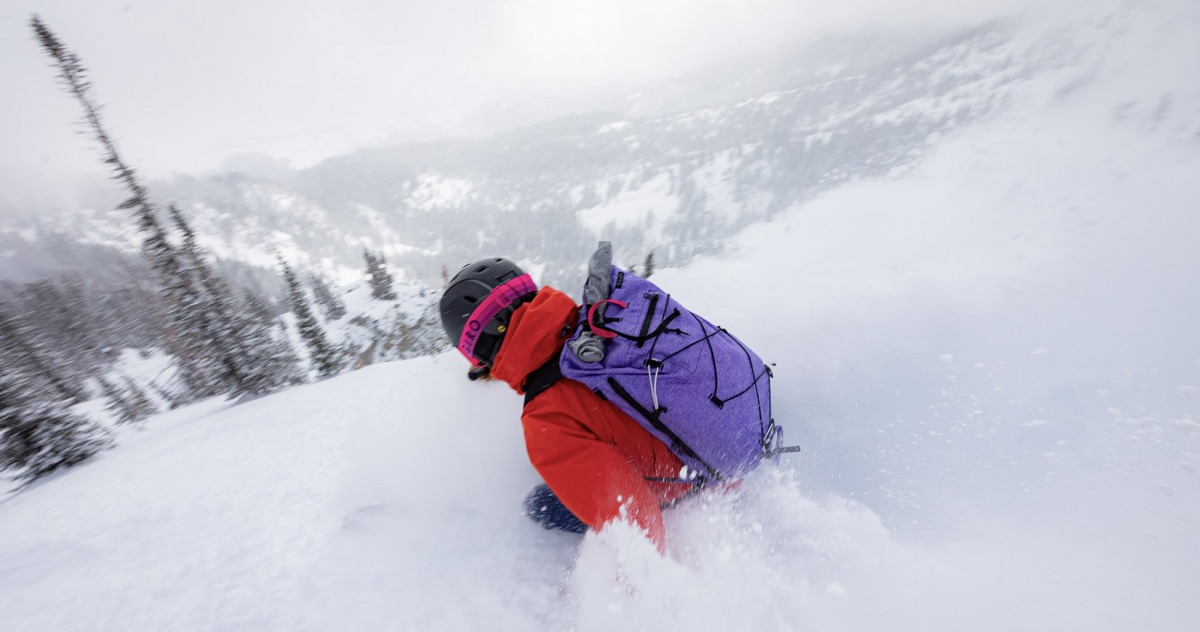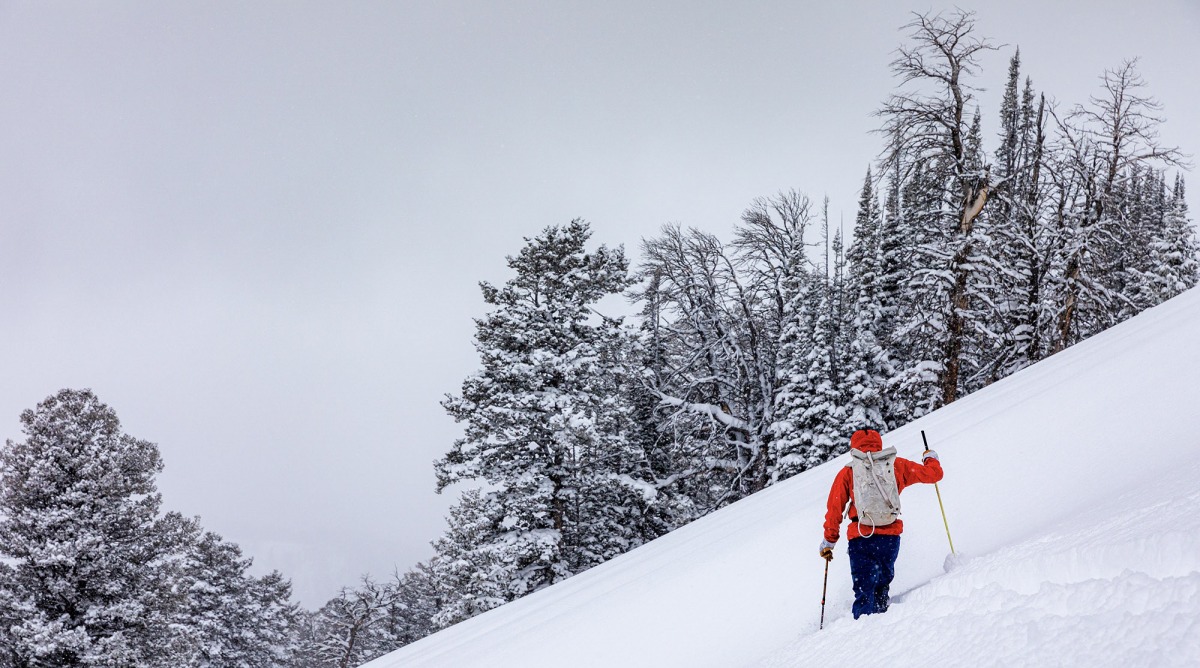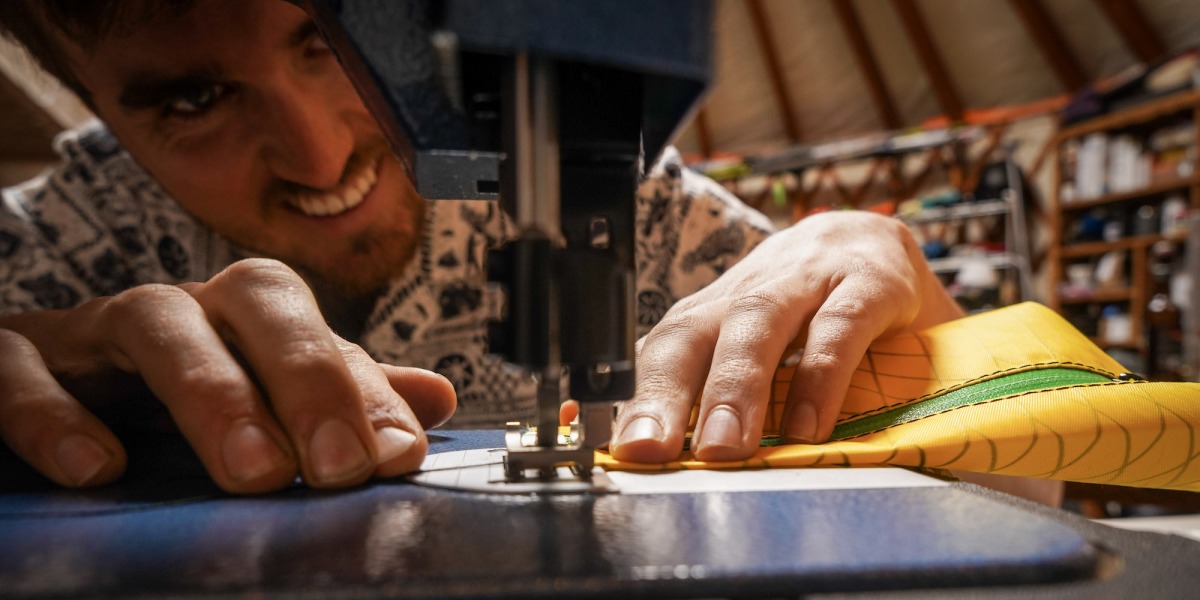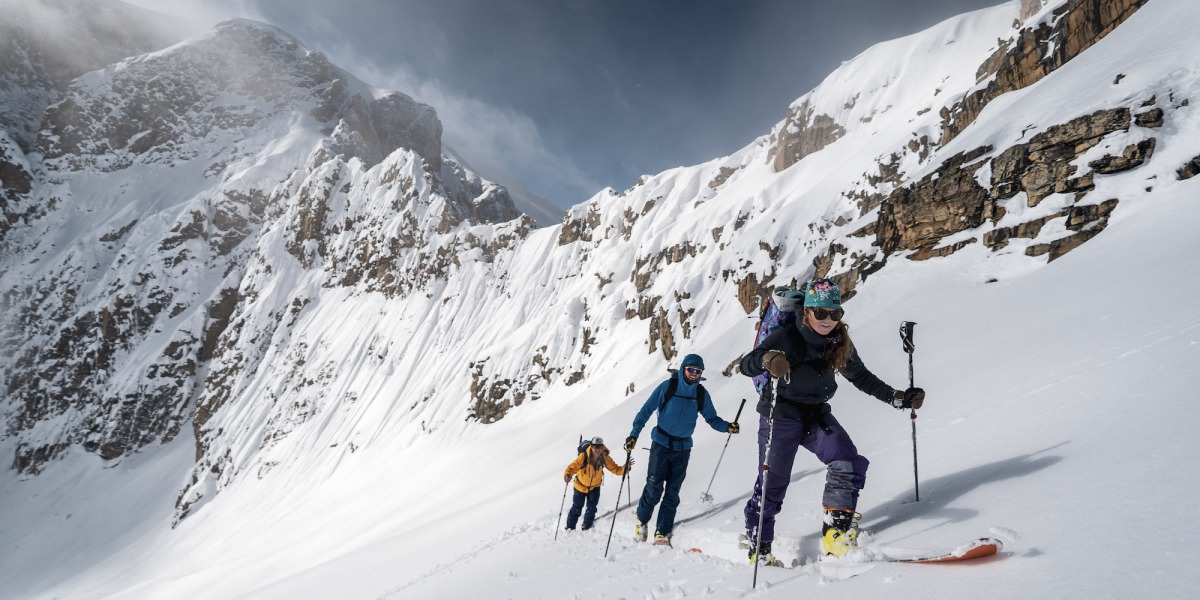
Gavin sewing together a fully custom Apocalypse Equipment SAC (Skiing And Climbing) in his yurt, on a ranch, in Jackson Wyoming, after a day of powder skiing / product testing, with the wood stove burning. Photo: Morgan Mcglashon
Exploring the essence of cottage (or, yurt) craftsmanship
Two seasons ago, I met a skier/climber named Gavin Hess in Bariloche, Argentina. We spent the spring season skiing around the phenomenal huts in the area. I immediately noticed his svelte green pack with no discernable manufacturer logo. I’m quite a gear-snob, so I abruptly introduced myself by asking about his get-up.
“Killer pack,” I said. “Who makes that?’
“Oh hey!” he replied while meticulously removing his pack and setting it on the ground for display, “I made this one. It’s alright but I’m hoping to change the shoulder straps next time. And the stitching is all wrong.’
“So you make packs?” I asked. “Where do you make them?”
“I’m bouncing around between my girlfriend’s parents’ garage and our van,” he replied “I have a great DC-AC clean wave inverter, so I can run my industrial sewing machine off of our solar panel.” He then proceeded to explain how he started making packs because “all the other packs out there suck…They don’t function properly and don’t hold up.”
The pack he had on that day was the Apocalypse Equipment SaC (Skiing and Climbing pack). It’s made from a woven dyneema/poly blend with a PU coating. This space-age fabric has great abrasion resistance and is waterproof. I’m really surprised more companies aren’t using this stuff. It feels soft and light, but can be beat up without showing any signs of wear. The pack has a simplistic look with a customizable exterior. It features a rolltop closure with an extendable collar, a stiff back panel, shovel handle and probe sleeves for organized backcountry equipment storage, A-Frame or diagonal ski carry, full-length side zipper to access the pack’s full interior, and an external zipper pocket. A grid of exterior attachment points further help individuals customize the pack to best fit their needs.
From that first encounter, Gavin and I got to be friends. We’ve shared many adventures skiing peaks, climbing rocks, and running trails. There’s always a common thread to our backcountry missions: obsessive and careful discussion about gear. We drone on and on about clothes, ropes, skis, helmets, or packs. Dissecting the most efficient ski carry or debating the downfalls of the average skimo harness.
Gavin’s self-taught hobby has turned into a time/life/energy consuming business that he named Apocalypse Equipment, named with the intent of his gear being able to survive an apocalypse. This spring, I sat down to talk with Gavin about the company’s progression from hobby to business, what it looks like to run a small outdoor gear brand, and what his packs are all about.
S: Thanks for sitting down to talk about your life and brand. What’s the story behind Apocalypse Equipment? How’d you start the company?
G: Apocalypse Equipment is a product of me obsessing over having the right equipment for the mountains. The summer before I moved to the Tetons, I made myself a sleeping bag, an insulated jacket, and a backpack in preparation for my new lifestyle. That gear is still around, but I gravitated towards tinkering with backpacks. Through many iterations (including that first green pack you saw me with), I slowly realized that I could make packs that were better suited to my needs than the big brand’s offerings. Apocalypse Equipment came to be when my friends started to ask for the gear that I was making. I guess I wasn’t the only person that wanted a pack that fits their needs in the mountains.
S: The company is primarily making the Apocalypse Equipment SaC (Skiing And Climbing pack). What’s the story behind that pack?
G: The packs are made for fast and light skiing and climbing because that’s what I like to do, so I know what’s nice to have and what’s not helpful. Each pack is made with the hope to get feedback per pack per customer in order to improve the product. Each customer adds to the design process. It’s fun to have the design be such a dynamic affair. I have guides or friends or strangers buy a pack, then reach out after a bit of time with photos of how the pack wore, or what they like, or drawings of how the pack could be improved. It’s really fun to have the design get so much community feedback.

Gavin blasts through knee deep bliss with the Apocalypse Equipment SAC strapped and ready to roll. Photo: Morgan Mcglashon

Gavin breaks trail with nothing but a dyneema rucksack on his pack. Product testing is hard in the Tetons, but someone has to do it, right?
S: Who are buying these packs? It seems hard to get in contact with you as such a small brand.
G: A lot of mountain guides and athletes here in the Tetons are interested in getting a pack and asking for personal design features. I think this group sees the value of a pack that is going to last and exactly tailors to their needs. The SaC is so durable that you can’t beat it up. The cost per use is lower than anything else even though the pack might initially be more expensive. The idea is you can choose between a cheaper pack that will last 100 days or the SaC that will last 500 days. I feel like people are starting to appreciate that sense of longevity. As for getting in contact with me: I just made a website. That was a huge mission which turned out to be way harder than expected. I’m still working on shipping and other business stuff like that. But if you reach out, I’d be happy to make you a pack.
S: How’s production going? Are you the only one making these?
G: That’s the crux right now. I make every pack either in my van [if we’re on a trip] or at our yurt in Jackson. But that’s never going to change; I want to focus on quality rather than ramp up production. However, there’s a lot of room for improvement when it comes to manufacturing efficiency. I can make about 8-10 packs per month currently. This varies with other work, personal trips, and expeditions. If I invest in some better sewing equipment and get a more organized workspace – that could dramatically help with being able to make more packs than what I can do now. All of that production and cost analysis is the hard part. Sitting down and making packs is so easy compared to figuring out how to make a pack that’s cost and time effective.

Morgan hops turns down through boot-top glory sporting an Apocalypse Equipment SAC in ‘Fairy Camo.’ Photo: Morgan Mcglashon

It is a long and methodical process to work with high performance fabrics. Include the custom requests and personalized colors – Gavin has his hands full with pack orders. Photo: Morgan Mcglashon
S: It seems like making and designing the packs is easy compared to the business side of things.
G: That’s exactly it! The hard part is all the business. I need to see if I can turn this passion into a career, and the next step is buckling down and focusing on Apocalypse Equipment as a business. I feel so over my head when it comes to finances, business plans, product sources, and all of that stuff. It’s so fun to make packs and improve the design of the product, but there’s so much more to a business than that.
S: Well, I wish you the best of luck with navigating that space. It better not cut into our skiing time this winter season!
Readers: Are there other cottage companies out there in the backcountry ski world doing small scale manufacturing? I’d love to hear about them in the comments below. Gavin is busy these days working on a remote guest ranch in Wyoming’s Gros Ventre Wilderness, training a new puppy (Neve) with his girlfriend Morgan, sport climbing on Wyoming’s great limestone, oh, and making packs for those dedicated to moving through mountains with style and ease.
Slator Aplin lives in the San Juans. He enjoys time spent in the mountains, pastries paired with coffee, and adventures-gone-wrong. You can find him at @slatoraplin on Instagram or outside Telluride’s local bakery — Baked in Telluride.
Slator Aplin lives in the San Juans. He enjoys time spent in the mountains, pastries paired with coffee, and adventures-gone-wrong. You can often find him outside Telluride’s local bakery — Baked in Telluride.

